Flowering Trees In Florida (Native and Non-Native) – with Pictures, Names and Identification
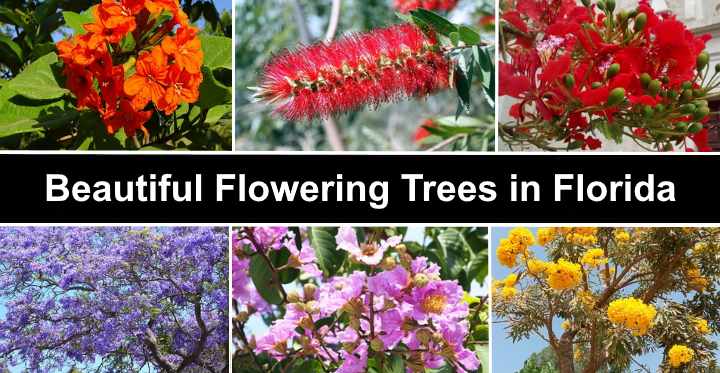
Flowering trees in Florida are beautiful additions to any southern garden landscape. Many tropical deciduous and evergreen trees that produce vibrant blooms thrive in Florida’s climate. Small trees can bloom year-round in the Sunshine State, adding bursts of color, delightful fragrances, and visual appeal to your garden. Tall flowering trees are particularly suitable for providing shade in Florida’s warm, humid climate.
Whether you reside in the northern Gulf Coast region of Florida or in the southern vicinity near the Florida Keys, you can discover magnificent flowering trees to enhance your southern landscape.
This article is a comprehensive guide to the best flowering trees for growing in Florida. You will learn about native Florida trees with white, yellow, pink, red, and purple blooms. Additionally, you will find out which non-native trees thrive in Florida’s unique subtropical climate.
What Are Flowering Trees?
Flowering trees are prized for their stunning floral beauty when they bloom with pink, purple, yellow, red, and white flowers. Many flowering trees also have fragrant flowers that fill gardens in warm climates with a sweet fragrance. Evergreen flowering trees in Florida also provide year-long shade because they keep their lush foliage.
If you live in Florida, flowering trees are a long-term investment in your garden landscape. Trees in bloom can add colorful height to your garden space. In addition, because many flowering trees in Florida are evergreen, they are easy to maintain and cause little mess in your garden.
Growing Zones for Flowering Trees in Florida
Before choosing which trees to plant in your southern garden, it’s vital to learn about growing zones in Florida. The USDA zone map for plant hardiness shows Florida has four zones.
Here there the cold hardiness zones in Florida:
- USDA zone 8 in the northwest and includes cities like Tallahassee, Panama City, and Pensacola. The average minimum winter temperature is 20°F (-6.6°C).
- USDA zone 9 covers most of Florida’s central east and west coast, with Jacksonville, Tampa, and Orlando included. The average minimum winter temperature is 25°F (-3.8°C).
- USDA zone 10 includes Fort Myers and Naples. Average minimum winter temperature is 30°F to 35°F (-1.1°C – 1.7°C)
- USDA zone 11 is the southernmost point of Florida where Fort Lauderdale, Miami, and the Florida Keys are located. The average winter minimum temperature is 40°F (4.4°C)
How to Choose Flowering Trees in Florida
Choosing the perfect tree with colorful blooms for your landscape in Florida requires considering a few factors. The most crucial factor is the cold hardiness zone. Then it’s vital to think about the size of the tree, sun tolerance, and type of soil. Most flowering trees require planting in well-drained soil.
Then think about if you want an evergreen flowering tropical tree or a deciduous tree. Remember that deciduous flowering trees can become messy and require cleanup in dry periods when the leaves drop.
Location is another consideration. For example, if you live near the coast, salt tolerance is a crucial factor. However, some trees may suffer in South Florida if there is no afternoon shade from the scorching sun. But in North Florida, some zone 10 trees may not perform well if there are extended periods of frost.
Flowering Trees in Florida (with Pictures) – Identification
Let’s look in more detail at some of the most spectacular ornamental trees with colorful flowers and fragrant blossoms that thrive in Florida’s climate. For each tree, you will find out the color of blooms and how to identify each gorgeous flowering tree.
Crape Myrtle Tree (Lagerstroemia)
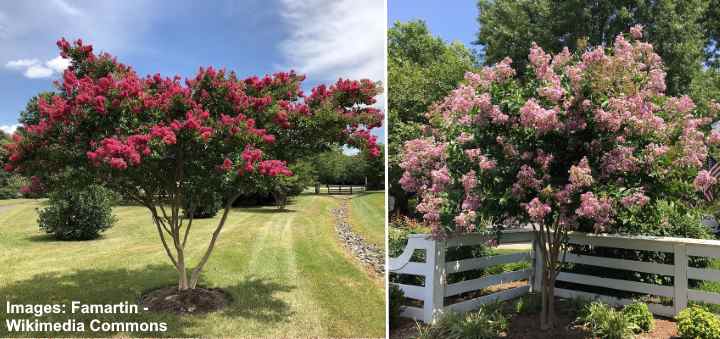
Crape myrtles are small flowering trees that can be grown in all Florida USDA zones
Crape myrtle trees produce dense clusters of attractive blooms in shades of pink, purple, white, or red. The multi-stemmed flowering trees have spectacular gray or light brown bark that exfoliates, revealing a pinkish inner bark. The deciduous tree’s light green foliage turns stunning shades of yellow or red in the fall.
All varieties of non-native crape myrtle trees are suitable for planting in all of Florida’s growing zones.
Florida Flowering Tree Color: Clusters of white, pink, purple, lavender, or red blooms in summer.
Florida Flowering Tree Identification: Crepe myrtle trees are identified by abundant clusters of crinkly pink, red, white, and purple flowers. Crape myrtles have an oval crown consisting of small, ovate green leaves, and most of the trees grow between 3 and 15 ft. (1 – 4.5 m) tall.
Further reading: Crape Myrtles: Trees, Dwarf Plants and Shrubs.
Bottlebrush Tree (Melaleuca linearis)

Bottlebrush tree has fuzzy red flowers and can be grown in Florida in zones 9 – 11
The bottlebrush tree is a small, flowering tree with a rounded crown, bright red tubular blooms, and fragrant linear leaves. Bottlebrush trees get their name from the flowers’ shape. They are cylindrical spiky-looking blooms resembling a bottlebrush. These fast-growing Florida trees grow 3 to 8 ft. (1 – 2.4 m) tall.
Bottlebrush trees are cold-hardy in USDA zones 9 through 11. In addition, they are salt-tolerant, making them ideal for growing in Florida’s coastal regions.
Florida Flowering Tree Color: Bright red fuzzy summer blooms.
Florida Flowering Tree Identification: Bottlebrush trees have easily recognizable tubular brush-like flowers that bloom throughout the year.
Weeping Bottlebrush Tree (Melaleuca viminalis)
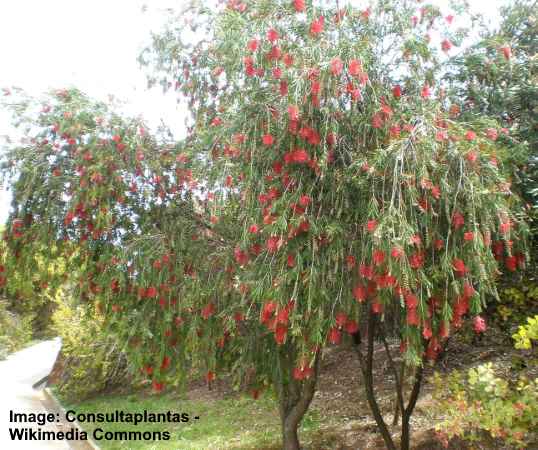
Weeping bottlebrush trees add a decorative look to Florida garden landscapes
The weeping bottlebrush tree is a spectacular Florida flowering tree with pendulous branches and bright red brush-like blooms. The red fuzzy flowers bloom abundantly on cascading branches and contrast nicely with the drooping lance-shaped green leaves. This graceful, multi-stemmed weeping bottlebrush tree grows moderately fast and matures at 15 ft. (4.5 m) tall.
Bottlebrush trees are cold hardy in Florida’s central and southern regions (zone 9 to 11).
Florida Flowering Tree Color: Bright red floral spikes blooming off and on throughout the year.
Florida Flowering Tree Identification: The weeping bottlebrush tree is identified by its pendulous branches and abundance of red flowers that look like bottlebrushes.
Hong Kong Orchid Tree (Bauhinia X Blakeana)
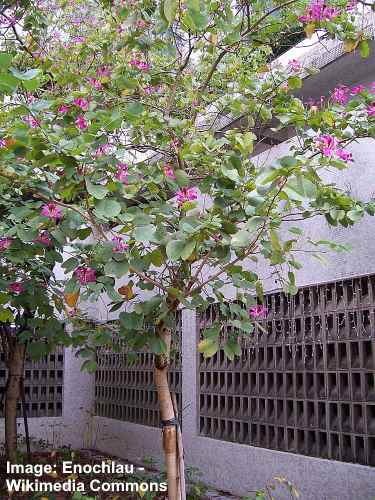
The Hong Kong orchid tree makes an ornamental tree desirable for Florida gardens with its attractive pink flowers
The Hong Kong orchid tree has spectacular orchid-like lavender-pink blooms, butterfly-shaped leaves, and a large rounded crown. Orchid trees are suitable as shade trees in extensive Florida gardens. The fast-growing tree with its spreading canopy reaches between 30 and 40 ft. (9 – 12 m) tall.
Although Hong Kong orchid trees are evergreen, they can lose their leaves in cold winter in Florida’s zone 8. However, in zones 9 to 11, the orchid trees keep their leaves throughout the year and have a long blooming time.
Florida Flowering Tree Color: Pink showy flowers that bloom from October through March.
Florida Flowering Tree Identification: The Hong Kong orchid tree is a spreading evergreen tree with pink flowers and slightly drooping branches.
Related article: Orchid Tree (Bauhinia): Purple, Pink, White and Hong Kong Orchid Trees.
Jacaranda Tree (Jacaranda mimosifolia)
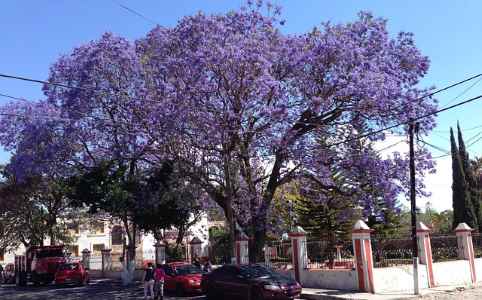
Jacaranda tree is a type of purple flowering tree suitable to growing in Florida zones 10 – 11
The Jacaranda tree has huge clusters of purple spring flowers, fern-like leaves, and an uneven vase-shaped crown. When Jacaranda trees bloom in spring, the purple flowers seem to cover the entire tree. The Jacaranda is a drought-tolerant tree that is fast-growing and thrives in full sun and organically rich, moist, well-drained soil.
Jacaranda trees thrive in USDA zones 10 and 11.
Florida Flowering Tree Color: Purple flower clusters in spring and early summer.
Florida Flowering Tree Identification: The Jacaranda tree is identified by its masses of purple flowers and tall, spreading crown. The trees grow up to 20 ft. (6 m) tall.
Trumpet Tree (Tabebuia Tree)
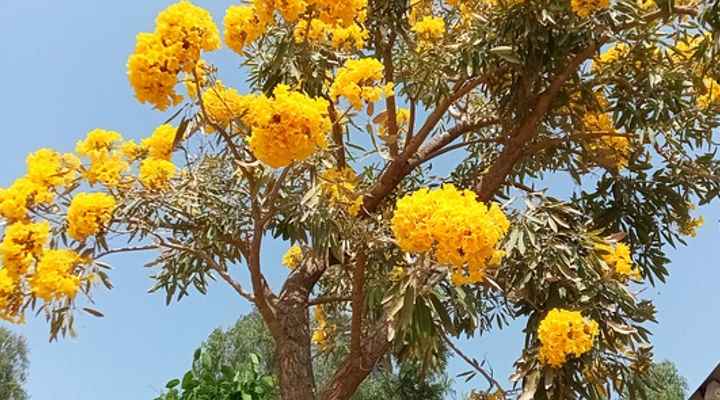
Trumpet trees are easy care and low maintenance trees with fluffy yellow or pink flowers
The trumpet tree is an ornamental flowering tree that thrives in Florida’s climate. The colorful pink or yellow flowering tree has abundant trumpet-shaped flowers blooming in spring. In warmer zones, the beautiful tree occasionally blooms at other times. Most varieties of trumpet trees are moderate to fast growers and mature at 20 to 30 ft. (6 – 9 m) tall.
Trumpet trees are suitable for zones 9 through 11. The tree is drought tolerant and requires little maintenance in a garden landscape.
The Tabebuia tree has minimal leaves that don’t obscure the beautiful funnel-shaped flowers.
Florida Flowering Tree Color: Prolific yellow or pink trumpet-shaped blooms.
Florida Flowering Tree Identification: The best way to identify the trumpet tree is by its tubular flowers consisting of several frilly petals and measuring 1” to 4” (2.5 – 10 cm) in size.
Golden Rain Tree (Koelreuteria paniculata)
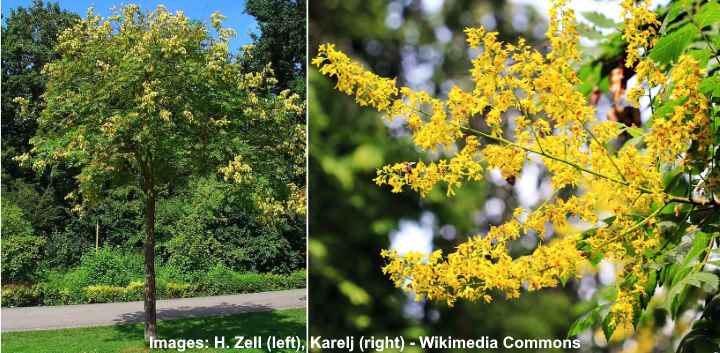
The golden rain tree is a small-medium flowering tree that can grow up to 23 ft. (7 m) high
The golden rain tree is a spectacular deciduous yellow flowering tree for Florida landscapes. Its masses of bright yellow, star-shaped flowers create showy summer floral displays. The yellow flowers grow in spiked clusters measuring 12” (30 cm) long and can turn the entire large tree yellow when blooming.
The golden rain tree is a low-maintenance landscape tree that is tolerant of drought. Plant in USDA zones 6 through 9 in well-drained soil.
Florida Flowering Tree Color: Panicles of bright gold or yellow flowers.
Florida Flowering Tree Identification: The golden rain tree is identified by its open branching, rounded canopy of feathery leaves, and clusters of golden yellow summer flowers.
Royal Poinciana (Delonix regia)
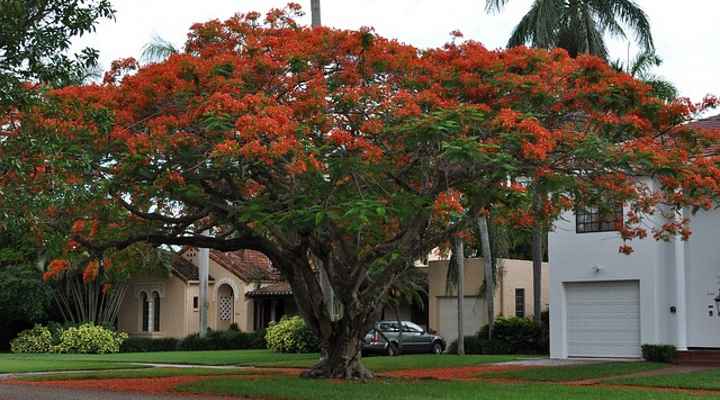
The beautiful royal poinciana tree grows well in Central and South Florida and has orange-red flowers
The royal poinciana is a gorgeous Florida shade tree with bright orange-red flowers. The multi-stemmed royal poinciana tree has a broad, spreading canopy forming an umbrella shape consisting of feathery green, fern-like leaves. When in bloom from late spring until early summer, the tree is covered with masses of brilliant red-orange flowers.
Also called the flamboyant tree, flame tree, or peacock flower, the tropical royal poinciana tree thrives in Central Florida and South Florida.
Florida Flowering Tree Color: Brightly colored red-orange flowers blooming in spring and summer.
Florida Flowering Tree Identification: The royal poinciana is identified by its broad spreading umbrella-like crown, smooth gray bark, and a profusion of orange flowers covering the tree in spring and summer.
Geiger Tree (Cordia sebestena)
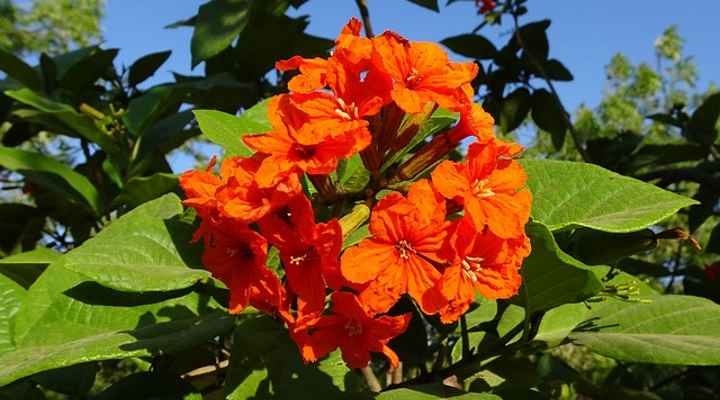
Geiger tree is native to Florida and thrives in Florida Keys
The Geiger tree is an evergreen shrub-like small tree that thrives in southern Florida. The tropical tree’s showy blooms are vivid orange clusters consisting of flowers that are made up of six fused papery petals. The stunning tubular flowers measure 2” (5 cm) wide and bloom throughout the year, especially in summer.
The Geiger tree is native to Florida and thrives in the Florida Keys. The tree is named after a Key West wrecker John Geiger. Gieger trees grow between 25 and 30 ft. (8 – 9 m) tall and feature a vase-shaped crown and drooping branches.
Florida Flowering Tree Color: Orange clusters of papery flowers that bloom in spring and summer.
Florida Flowering Tree Identification: The identifiable features of the Geiger tree are its clusters of orange blooms followed by pear-shaped fruits that give off a fragrant scent.
Saucer Magnolia Tree (Magnolia x soulangeana)
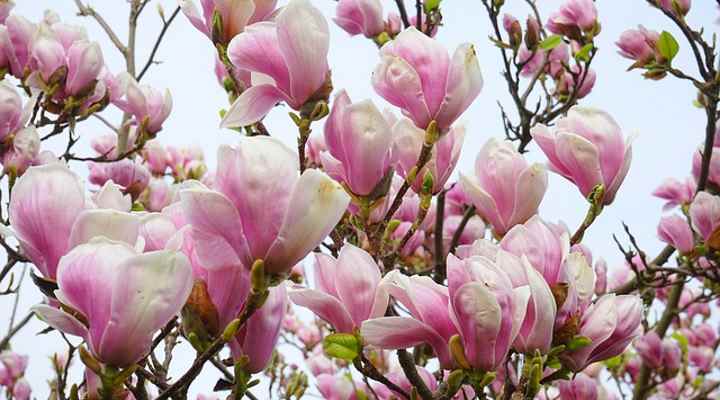
Saucer magnolia tree grows between 15 and 20 ft. (4.5 – 6 m) tall and has a rounded, spreading crown
The saucer magnolia tree is an impressive flowering tree that graces many northern and central Florida landscapes. The ornamental magnolia tree has huge pinkish-white flowers that grow between 4” and 12” (10 – 30 cm) across. The large floral blooms point upward and appear in spring before the deciduous tree leaves appear.
The saucer magnolia is suitable for gardens in Florida in zone 9. The flowering tree thrives in fertile, moist, well-drained soil and full sun. Being a small to medium tree type, the saucer magnolia is ideal for small gardens for floral accents and fragrant flowers.
Florida Flowering Tree Color: The beautiful magnolia flowers are usually two-toned and can be pink, white, purple, or magenta.
Florida Flowering Tree Identification: To identify a saucer magnolia, look for cup-shaped pink flowers growing on a small to medium tree with medium green, ovate leaves.
Related reading: How to care for magnolia trees.
Eastern Redbud Tree (Cercis canadensis)
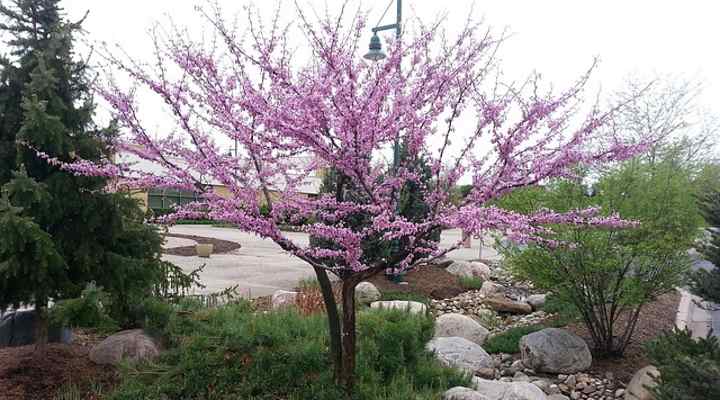
Eastern redbud flowers come in various shades of pink color and are suitable for Northern and upper Central Florida
The eastern redbud is a native Florida tree that produces masses of small pink pea-like flowers in early spring. Eastern redbud trees are identified by their irregular vase or rounded crown, heart-shaped leaves, and long bean pods that follow the flowers. Redbud trees grow 20 to 30 ft. (8 – 9 m) tall.
Eastern redbuds thrive in zones 6 through 9; therefore, you can plant these small multi-stemmed trees in northern Florida and the warmer regions of central Florida.
Florida Flowering Tree Color: Clusters of small pink or white flowers blooming on bare branches.
Florida Flowering Tree Identification: You can identify the eastern redbud tree by its heart-shaped leaves, clusters of small pink flowers, and long dangling brown or burgundy-red bean pods.
Further reading: Types of Redbud Trees: Eastern, Western, Chinese, and More.
Oleander Tree (Nerium oleander)
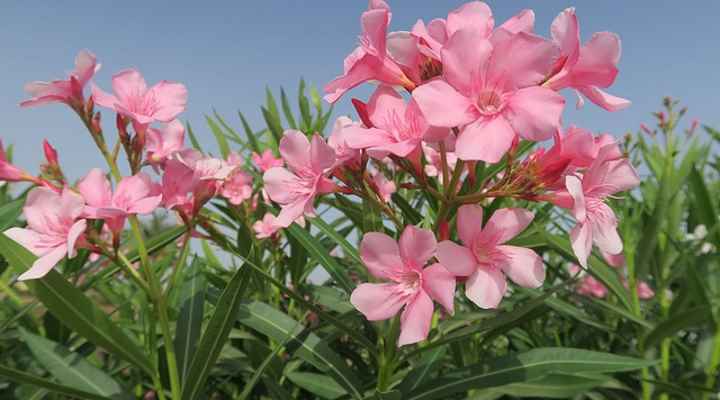
Oleanders are flowering trees with a variety of flower colors that can be grown in all Florida zones
The oleander tree is a breathtaking tree for growing in all regions of Florida. Oleander trees have spectacular booms with clusters of flowers in pink, red, lilac, purple, orange, or yellow shades. Oleander evergreen trees have shrub-like growth and spread out to form a rounded bushy tree. Additionally, oleander trees are salt-tolerant and drought-resistant.
Flowering oleander evergreen trees grow between 6 and 15 ft. (1.8 – 4.5 m) tall. This makes the shrub-like flowering tree suitable for gardens throughout the state of Florida.
Florida Flowering Tree Color: Showy oleander flowers can be shades of orange, light purple, red, pink,
Florida Flowering Tree Identification: To identify an oleander tree, look for colorful funnel-shaped, fragrant flowers and 6” (15 cm) lanceolate evergreen leaves growing in whorls of three or four blades.
Flowering Trees in Southern Florida
Some species of flowering trees are only suitable for growing in Florida’s zones 10 and 11. Here are a few gorgeous trees that thrive in South Florida.
Frangipani (Plumeria)
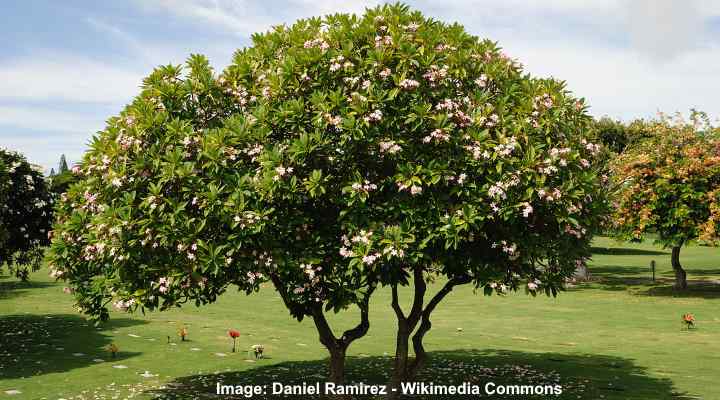
Plumeria is a flowering shrub-like tree that thrives in Southern Florida
Plumeria is a group of small trees that thrive in the southern regions of Florida. Plumeria trees (also called frangipani trees) are prized for their fragrant five-petalled star-shaped tropical flowers. The spectacular trees, with their large lance-shaped green leaves, bloom from May through November. However, most plumeria trees lose their leaves during winter.
Frangipani trees are vigorous growers and prolific bloomers. The shrub-like trees grow between 20 and 25 ft. (6 – 7.6 m) high with a similar spread.
Florida Flowering Tree Color: Frangipani flowers can be yellow and white, shades of pink, or a combination of oranges, pinks, and reds.
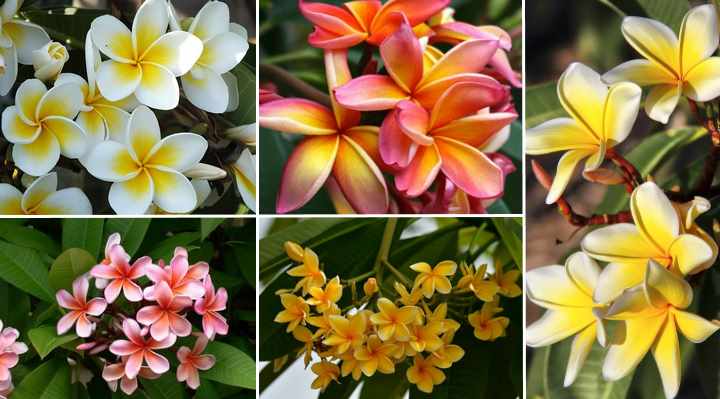
Plumeria flower colors
Florida Flowering Tree Identification: To identify plumeria trees, look for long green leaves 12” to 18” (30 – 45 cm) long with prominent yellow veins and showy white, pink, or red flowers. Plumeria foliage turns red in the fall.
Further reading: Plumeria Tree: Flower, Fertilizer, Cutting Propagation and Care Guide.
Silk-Floss Tree (Ceiba speciosa)
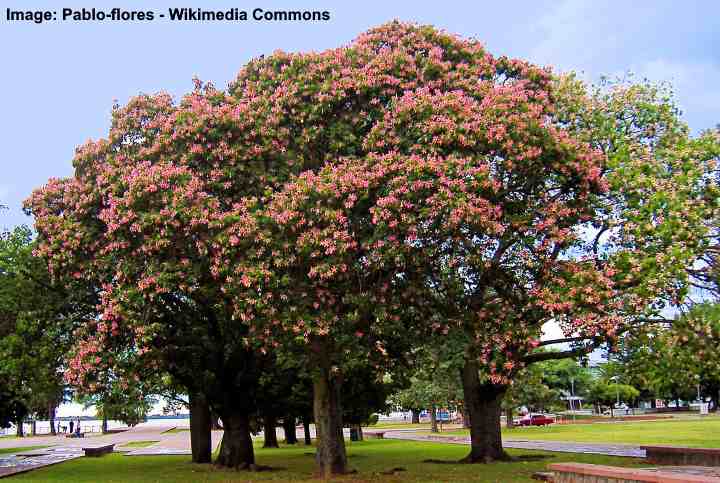
Silk-Floss tree have beautiful flowers but very thorny trunk
The silk-floss tree is a deciduous flowering tree for planting in southern Florida landscapes. Silk-floss trees have showy white and pink five-petaled flowers that look like hibiscus flowers. The clusters of beautiful flowers appear in fall and winter on bare branches. Silk-floss trees grow between 35 and 50 ft. (10 – 15 m) tall and spread up to 55 ft. (17 m) wide.
Silk-floss trees thrive in zones 9b through 11. However, it’s good to beware that the trunk is incredibly thorny and can injure a person or animal if they brush against it.
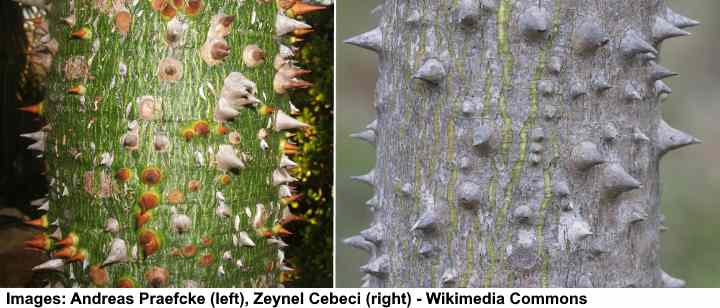
Thorns on Silk-Floss trunk
Florida Flowering Tree Color: Showy blooms are pink with white center.
Florida Flowering Tree Identification: The thick, thorny trunk, rounded crown, showy pink flowers, and seed pod filled with a white silky candy-floss substance help identify silk-floss trees.
Hibiscus Tree (Hibiscus rosa-sinensis)
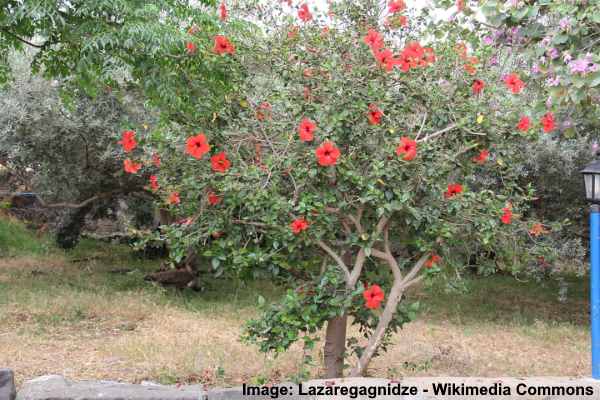
Chinese hibiscus tree (Hibiscus rosa-sinensis)
Hibiscus trees are prized in southern Florida gardens for their tropical flowers, like colorful trumpets with showy protruding stamens. Tropical hibiscus trees’ five-petaled blooms come in shades of pink, orange, white, purple, and red. Some of the showiest hibiscus plants in Florida have multi-colored flowers.
Also called Chinese hibiscus, the tropical trees thrive in USDA zones 10 through 12. The evergreen Florida shrub-like tree grows 8 – 10 ft. (2.4 – 3 m) tall and performs best in full sun to encourage blooming.
Find out about species of hibiscus that are suitable for colder climates.
Florida Flowering Tree Color: Tropical hibiscus flowers can be vibrant reds or pinks, brilliant white, warm yellows, or pastel.
Florida Flowering Tree Identification: Hibiscus trees are identified by their glossy green leaves, showy trumpet-like colorful flowers that bloom throughout the summer, and their shrub-like appearance.
Related articles:
